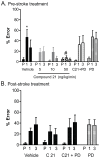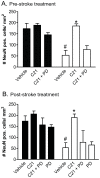Direct angiotensin AT2 receptor stimulation using a novel AT2 receptor agonist, compound 21, evokes neuroprotection in conscious hypertensive rats
- PMID: 24752645
- PMCID: PMC3994132
- DOI: 10.1371/journal.pone.0095762
Direct angiotensin AT2 receptor stimulation using a novel AT2 receptor agonist, compound 21, evokes neuroprotection in conscious hypertensive rats
Abstract
Background: In this study, the neuroprotective effect of a novel nonpeptide AT2R agonist, C21, was examined in a conscious model of stroke to verify a class effect of AT2R agonists as neuroprotective agents.
Methods and results: Spontaneously hypertensive rats (SHR) were pre-treated for 5 days prior to stroke with C21 alone or in combination with the AT2R antagonist PD123319. In a separate series of experiments C21 was administered in a series of 4 doses commencing 6 hours after stroke. A focal reperfusion model of ischemia was induced in conscious SHR by administering endothelin-1 to the middle cerebral artery (MCA). Motor coordination was assessed at 1 and 3 days after stroke and post mortem analyses of infarct volumes, microglia activation and neuronal survival were performed at 72 hours post MCA occlusion. When given prior to stroke, C21 dose dependently decreased infarct volume, which is consistent with the behavioural findings illustrating an improvement in motor deficit. During the pre-treatment protocol C21 was shown to enhance microglia activation, which are likely to be evoking protection by releasing brain derived neurotrophic factor. When drug administration was delayed until 6 hours after stroke, C21 still reduced brain injury.
Conclusion: These results indicate that centrally administered C21 confers neuroprotection against stroke damage. This benefit is likely to involve various mechanisms, including microglial activation of endogenous repair and enhanced cerebroperfusion. Thus, we have confirmed the neuroprotective effect of AT2R stimulation using a nonpeptide compound which highlights the clinical potential of the AT2R agonists for future development.
Conflict of interest statement
Figures








References
-
- Arnold JM, Yusuf S, Young J, Mathew J, Johnstone D, et al. (2003) Prevention of Heart Failure in Patients in the Heart Outcomes Prevention Evaluation (HOPE) Study. Circulation 107: 1284–1290. - PubMed
-
- Chapman N, Huxley R, Anderson C, Bousser G, Chalmers J, et al. (2004) Effects of a perindopril-based blood pressure-lowering regimen on the risk of recurrent stroke according to stroke subtype and medical history. Stroke 35: 116–121. - PubMed
-
- de Gasparo M, Catt K, Inagami J, Wright J, Unger T (2000) International Union of Pharmacology- the angiotensin II receptors. Pharmacological Reviews 52: 415–472. - PubMed
-
- Li J, Culman J, Hortnagl H, Zhao Y, Gerova N, et al... (2005) Angiotensin AT2 receptor protects against cerebral ischemia-induced neuronal injury. the FASEB journal 10. - PubMed
-
- Zhu M, Natarajan R, Nadler JL, Moore JM, Gelband CH, et al. (2000) Angiotensin II increases neuronal delayed rectifier K+ current: role of 12-lipoxygenase metabolites of arachidonic acid. Journal of Neurophysiology 84: 2494–2501. - PubMed
Publication types
MeSH terms
Substances
LinkOut - more resources
Full Text Sources
Other Literature Sources
Medical

